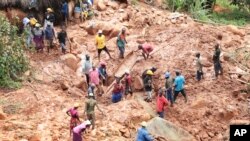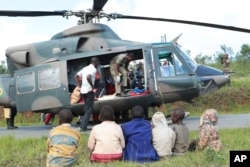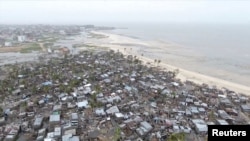Cyclone Idai may be one of the worst weather disasters ever recorded in the southern hemisphere, U.N. experts say, with Mozambique suffering the brunt of the storm.
Idai tore across Mozambique, Malawi and Zimbabwe late last week, leaving behind a trail of devastation, including more than 350 people killed, hundreds missing, and hundreds of thousands homeless.
Mozambique's death toll exceeded 200 Tuesday, President Filipe Nyusi said, after saying earlier the final number of dead could top 1,000.
Officials say the cyclone created an "inland ocean" across the country.
The International Federation of Red Cross and Red Crescent Societies called the damage to the coastal city of Beira "massive and horrifying." They estimate 90 percent of the city was destroyed.
Rescue workers were dropping food, fresh water, and blankets to flood victims stranded on roofs, treetops, and any high piece of land. Airdrops are the only way to help most people in Beria, where roads are under water and communications gone.
Mozambique-based UNICEF spokesman Daniel Timme told VOA via Skype Tuesday officials are still getting details on the impact of the storm.
"At the moment, we still don't have the full picture of the situation, but we agree with the assessment of the government that the disaster is of a dimension which is much, much bigger than we thought in the beginning," he said. "This is due to the fact that information was coming in very slowly, because the city of Beira had been cut off of all communication lines and still is, and has also been cut off physically because the roads to Beira are destroyed."
Timme says UNICEF is appealing to international donors for more than $20 million to support its response in the three affected countries.
"We are at the same time actually preparing to supply people with the most urgent things. What is very important in such situations is the supply of safe drinking water, so we will be supplying water purification pills."
South Africa sent a military force to Mozambique to help with the rescue and recovery. International relations spokesman, Ndivhuwo Mabaya, tells VOA South Africa will try to do more.
"We have also called on South African companies to donate for humanitarian assistance and following this morning's assessment, we'll make a further announcement for how we'll assist going forward," he said Tuesday.
In Zimbabwe, the death toll stood at 98 Tuesday. One local government official says bodies from Zambia have been flowing on the river into neighboring Mozambique.
Malawi's government put the death toll in that country at 56 with nearly 600 people suffering from storm-related injuries.
The European Union announced Tuesday it is sending an initial $4 million in aid to the three devastated countries. Britain has also pledged a separate aid package and the U.S. embassy in Zimbabwe said it is "mobilizing to provide support," without giving any details.
Anita Powell contributed to this report.











